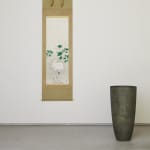Kobayashi Kokei (1883−1957)
Rabbit
Color on paper, hanging scroll
With a box signed by the artist, double boxed
Seal: Shigeru in
123 x 42.3 cm
214 x 57 cm (overall)
Further images
A bunch of knotweed stretch out over all directions, creating a delightful atmosphere. A rabbit comes to a halt with its left ear flopped, facing toward the viewer, as if it were aware of our gaze. Once it notices our existence, it would change its direction and hop away in less than no time. Thanks to the thistle in the foreground between the rabbit and the viewer that shrouds the human existence, the rabbit remains crouching in the same position calmly.
The red of the knotweed blossom and the green of its leaves exquisitely complement each other. On depicting the leaves, Kokei applied the tarashikomi technique, which layered light green pigment over wet, thinly-applied ink. Edges of the leaves are rendered in a rather natural manner in this way. This work harmoniously integrates line and color, manifesting the appeal of these two distinguishing features of nihonga to a great extent.
Kobayashi Kokei (nihonga painter; 1883−1957)
Niigata-born nihonga painter. His real name is Shigeru. Moved to Kyoto and became a student of Kajita Hanko. Recognized as three exceptional painters at Inten (Japan Art Institute) together with Maeda Seison and Yasuda Yukihiko. Based on the nihonga tradition, he established a refined neo-classical style with modest expressions through incorporating realism and decorativeness. Appointed Tokyo School of Fine Arts professor. Designated as an Imperial Court Artist and a Person of Cultural Merit. Member of the Japan Art Academy. Received the Order of Culture.
The red of the knotweed blossom and the green of its leaves exquisitely complement each other. On depicting the leaves, Kokei applied the tarashikomi technique, which layered light green pigment over wet, thinly-applied ink. Edges of the leaves are rendered in a rather natural manner in this way. This work harmoniously integrates line and color, manifesting the appeal of these two distinguishing features of nihonga to a great extent.
Kobayashi Kokei (nihonga painter; 1883−1957)
Niigata-born nihonga painter. His real name is Shigeru. Moved to Kyoto and became a student of Kajita Hanko. Recognized as three exceptional painters at Inten (Japan Art Institute) together with Maeda Seison and Yasuda Yukihiko. Based on the nihonga tradition, he established a refined neo-classical style with modest expressions through incorporating realism and decorativeness. Appointed Tokyo School of Fine Arts professor. Designated as an Imperial Court Artist and a Person of Cultural Merit. Member of the Japan Art Academy. Received the Order of Culture.











